What happens next? A teaching strategy to get students of all ages talking Teach article
David Featonby, from the UK, presents some simple demonstrations to get your students thinking about scientific principles.
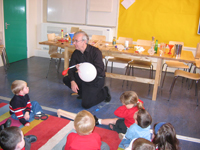
four-year-olds at Newburn
Manor Nursery School, UK,
discussing how the small balloon
inflates the large one
Image courtesy of David Featonby
Very often, meaningful discussion of science is limited to a small number of vocal students in a class. Here is a great way to get everyone in the class talking and thinking about science principles.
The following approach not only lends itself to groups of all ages and abilities, but has opened up discussions between children who normally make few positive contributions to lessons.
Furthermore, it can be applied in a variety of different cultures and educational systems, so could be used in different countries. When the approach has been tried as a full lesson, teachers have been most enthusiastic about the effect that it has had on their students, and the development of their thinking skills.
The idea is to present to the class a series of easily demonstrated experiments, all with slightly unusual outcomes, each one presenting opportunities for discussion. These experiments are sometimes referred to as discrepant events: the scientifically slightly unexpected. One approach is to arrange the students in small groups to compete with each other to predict the correct outcome and give the correct explanation for the situation. It provides an ideal alternative to the end-of-term trivia quiz! Groups are challenged to reach a consensus as to what might happen, having been given a series of possible outcomes. Alternatively these ideas can be used at the beginning or end of lessons over a whole year, so students can look forward to finding out ‘what happens next’ each week. The strategy could also be used for a revision session.
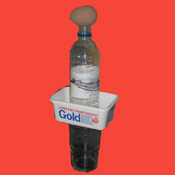
when the bottle is knocked
to the left?
Image courtesy of David Featonby

beanbags when the board
below is pushed sharply to
the left?
Image courtesy of David Featonby
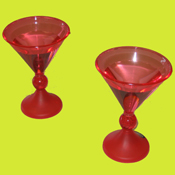
and fill the second almost-full
conical beaker with the water
from the first beaker?
Image courtesy of David Featonby
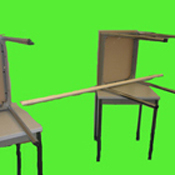
broomstick (suspended on
two threads) when it is
struck with a second
broomstick?
Image courtesy of David Featonby
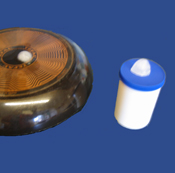
one on a plastic box; which
will melt first?
Image courtesy of David Featonby
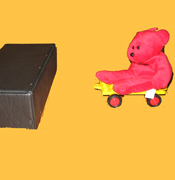
bear when the truck crashes
into the box?
Image courtesy of David Featonby
Younger children can be presented with simple ‘either/or’ experiments whereas older children can be offered more complicated situations that require deeper understanding. The strategy has been used successfully with students aged 5-18, and in training sessions for teachers. Younger children particularly like ideas they can take home and try out.
It is important that both students and teachers are able to understand what is happening; although the ideas should be interesting, experiments should not be too complex. Science is not about mystery and magic, but about seeing, investigating, believing and understanding. The following list describes some of the experiments that I have used. The examples illustrate mostly physics phenomena, but the strategy would work equally well with chemistry, biology or other science subjects.
With suitable questions, some of the later examples can also be used with younger children. I hope the ideas spark your imagination, and help you think of other experiments that lend themselves to this approach.
A much fuller list of suggestions is available onlinew1.
Readers are invited to submit their own additions and make comments on the Science in School website.
Example experiments
Ideas for students aged 5-11 (either/or situations)
| Idea | Question | Answer |
|---|---|---|
| Dropping balls | ||
| Drop a golf ball and a table-tennis ball simultaneously. | Will the balls land together or will one land before the other? | Yes The balls land together. Air resistance is not significant at low speeds. |
| Floating oranges | ||
| A whole orange floats in water. Peel the orange and put it back in the water. | Will the orange sink? | Yes The skin acts as a buoyancy aid (like armbands when swimming). |
| Melting ice | ||
| Put an ice cube on a metal frying pan and another on a plastic box. The box feels warm, whereas the pan feels cold. | Will the ice on the plastic box melt first? | No The ice on the metal pan (a good conductor) can obtain heat from the pan to melt it. |
Ideas for students aged 11+ (offer several solutions)
| Idea | Question | Answer |
|---|---|---|
| Sultanas in lemonade | ||
| Put some sultanas in a newly opened bottle (or freshly poured glass) of lemonade. | What will happen to the sultanas? A. They will float. B. They will sink. C. They will dissolve. D. Something else. |
D. The sultanas first sink, then bubbles attach to them so they rise again. The bubbles pop at the liquid’s surface, so the sultanas sink again. This process repeats. |
| Basketball and tennis ball | ||
| When you drop the basketball, it bounces. When you drop the tennis ball, it bounces. | If you place the tennis ball on top of the basketball and drop the two together, how high will the tennis ball bounce? A. It will bounce as high as before. B. It will bounce higher than before. C. It will hardly bounce. D. Something else. |
B. When you hit a ball with a bat, the ball goes further if you move the bat towards the ball. Similarly, the basketball is moving upwards after it bounces, towards the tennis ball, so the tennis ball bounces higher. |
| Burning a candle at both ends | ||
| Balance a candle (with open wick at each end) with a needle through its centre. One end will fall as the candle will not be perfectly balanced. | Light both ends. What will happen next? A. The candle burns but the high end stays high. B. As the candle burns the lower end eventually rises. C. The lower end rises, then falls, then rises, and so on. D. Something else. |
C. As the lower end burns, more wax melts and drops off, until that end of the candle rises. The same thing will then happen to the other end. The falling wax causes the candle to oscillate quite rapidly. |
| Falling candle | ||
| Place a lit tea-light (small, stable candle) in a glass jar. | Drop the jar and then catch it. What happens to the candle flame? A. It goes out. B. It gets much longer. C. It stays the same. D. Something else. |
A. The flame requires convection to work (the hot gases need to rise out of the way for oxygen to reach the burning wick). In a free fall, convection no longer occurs. |
Ideas for older students
| Idea | Question | Answer |
|---|---|---|
| Spouting bottle | ||
| Prick a small hole in the bottom of a plastic bottle. Fill the bottle with water so that it spouts out of the hole. | What will happen to the jet of water when the bottle is thrown up in the air? A. No change. B. The jet is longer on the way up and shorter on the way down. C. The jet stops while the bottle is in the air. D. Something else. |
C. The water is effectively weightless while the bottle is travelling (in free fall) both up AND down. (Its acceleration is 10 m/s2 downwards whether the bottle itself is moving up or down). |
| Eclipse of Mars | ||
| Stare at the centre of a red disc on a white background for about 30 seconds. (This is best done on-screen with a PowerPoint presentation.) | What will happen if the disc is moved away from you, or gets smaller? A. You see the red disc as before but smaller. B. The red disc will have a yellow halo. C. The red disc will have a green halo. D. The red disc will have a cyan halo. |
D. The ‘red’ cones in the eye become tired, so only the blue and green cones are used, producing a cyan halo around the disc. |
| Tin of beans | ||
| Tie some thin string around a tin of beans (or any 450 g tin) with one loose end above and one below. Suspend the beans from a rigid point (e.g. a hook in the ceiling or a door frame) using the string. | When you pull sharply on the string hanging below, where will the string snap? A. Above the beans. B. Below the beans. C. You can’t tell. |
B. The inertia of the beans resists change, so the string snaps below where the force is exerted. If you pull gently the string snaps above the tin because the full force is passed above the tin as you pull. |
Web References
- For a fuller list of experiment suggestions, see www.scienceonstage2.co.uk
- Science on Stage is a series of international teaching festivals organised by the EIROforum, who also publish Science in School: www.science-on-stage
Review
Teaching science principles in primary or secondary education is essential but usually not easy.
In this article, David Featonby provides teachers from all countries with a strategy and resources to encourage thinking skills and discussion in the classroom or school lab. By involving the class in a series of simple and easy experiments, each with slightly unusual outcomes, all pupils are engaged in an enjoyable and practical framework. This useful learning tool encourages students to participate, investigate and understand science principles.
This article could be used in various ways as a teaching aid. Teachers may use the experiments presented in the article, adjusting them to their students’ needs. Additionally, the article may prompt teachers to think of experiments in other science subjects, and realise them according to the successful approach presented here.
Vangelis Koltsakis, Greece





